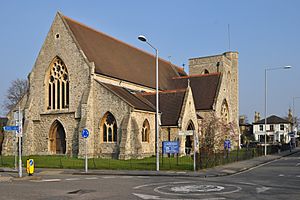St John's Church, Kingston upon Thames facts for kids
Quick facts for kids St John |
|
|---|---|
| St John the Evangelist | |

St John's Church
|
|
| 51°24′11″N 0°18′03″W / 51.4031°N 0.3008°W | |
| Location | Grove Lane Kingston, KT1 2SU |
| Country | United Kingdom |
| Denomination | Anglican |
| History | |
| Consecrated | November 1872 |
| Architecture | |
| Years built | 1871 |
| Administration | |
| Deanery | Kingston |
| Archdeaconry | Wandsworth |
| Diocese | Southwark |
The Church of St John the Evangelist, often called St John's Church, is an Anglican church. It is located in Kingston upon Thames, a town in the United Kingdom. This church is part of the Diocese of Southwark. You can find it just south of the town centre.
Contents
History of St John's Church
Early Beginnings
St John's Church started in June 1870. A temporary building made of iron was put up first. It stood at the corner of Springfield Road and Denmark Road. This was a simple start for the church community.
Building the Permanent Church
The foundation stone for the permanent church was laid in July 1871. Bishop Samuel Wilberforce helped with this important event. The land for the church was given by William Mercer. He also donated £2000 towards the building costs. Raising the full £7000 needed was a challenge.
The church was officially opened, or consecrated, in November 1872. At first, it did not have the tall tower or spire. These were part of the original design by architect A. J. Phelps. The inside was also quite plain.
Adding Details and the Tower
Over time, the church became more decorated. Carvings, paintings, and colourful windows were added. An organ was also installed for music. The tower, which was shorter and had an eight-sided turret, was finally built much later. It was completed in 1935.
Special Recognition
St John's Church is a very important building. Since March 1975, it has been a Grade II listed building. This means it is protected because of its special historical or architectural importance.
Changes Over Time
In 1974, some big changes happened inside the church. The long wooden benches, called pews, were taken out. New heating and lighting systems were put in. These changes allowed Kingston Polytechnic to use the church. They used it as a large hall for exams during the week. Later, the choir stalls and the pulpit were also removed.

